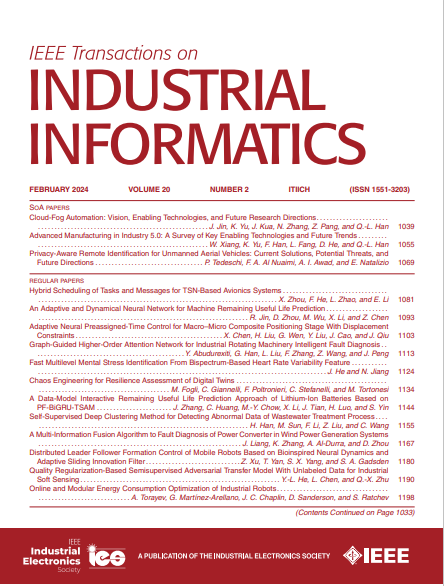基于广义分布匹配测度的深度迁移学习旋转机械故障诊断
IF 9.9
1区 计算机科学
Q1 AUTOMATION & CONTROL SYSTEMS
引用次数: 0
摘要
基于深度迁移学习的诊断模型具有将诊断知识应用于相关机器的潜力。然而,现有的方法有几个缺点。首先,卷积核的随机初始化缺乏可解释性,可能导致次优解,影响诊断准确性和训练收敛性。其次,平等对待所有通道限制了模型捕获关键信息的能力。第三,传统的领域对齐方法不能有效地利用高阶特征来匹配全局或局部特征信息。为了解决这些问题,本文提出了一种新的域自适应方法——多阶统计匹配稀疏小波卷积神经网络(MSM-SWCNN)。在MSM-SWCNN中,提出了一种多通道特征提取模块,利用稀疏小波卷积核从时域和频域进行综合特征提取。在此基础上,提出了一种新的广义分布匹配方法,用于对齐两个域之间的特征和分布。对于轴承和齿轮两个数据集的8个传递任务,诊断准确率可达96.6%以上。结果表明,该方法优于其他旋转机械故障诊断方法。本文章由计算机程序翻译,如有差异,请以英文原文为准。
Deep Transfer Learning With Generalized Distribution Matching Measure for Rotating Machinery Fault Diagnosis
Diagnostic models based on deep transfer learning hold the potential to apply diagnostic knowledge across relevant machinery. However, existing methods suffer from several drawbacks. First, the random initialization of convolutional kernels lacks interpretability and may lead to suboptimal solutions, affecting diagnostic accuracy and training convergence. Second, treating all channels equally limits the ability of the model to capture crucial information. Third, traditional domain alignment methods do not effectively utilize high-order features for matching global or local feature information. To address these issues, a novel domain adaptation method named multiorder statistics matching sparse wavelet convolutional neural network (MSM-SWCNN) is proposed in this article. In MSM-SWCNN, a multichannel feature extraction module is proposed to utilize sparse wavelet convolutional kernels for comprehensive feature extraction from both time and frequency domain. In addition, a novel generalized distribution matching measure is proposed to align features and distribution between two domains. For eight transfer tasks in two datasets of bearings and gears, the diagnostic accuracy can reach more than 96.6%. The results demonstrate that the proposed method outperforms other methods for rotating machinery fault diagnosis.
求助全文
通过发布文献求助,成功后即可免费获取论文全文。
去求助
来源期刊

IEEE Transactions on Industrial Informatics
工程技术-工程:工业
CiteScore
24.10
自引率
8.90%
发文量
1202
审稿时长
5.1 months
期刊介绍:
The IEEE Transactions on Industrial Informatics is a multidisciplinary journal dedicated to publishing technical papers that connect theory with practical applications of informatics in industrial settings. It focuses on the utilization of information in intelligent, distributed, and agile industrial automation and control systems. The scope includes topics such as knowledge-based and AI-enhanced automation, intelligent computer control systems, flexible and collaborative manufacturing, industrial informatics in software-defined vehicles and robotics, computer vision, industrial cyber-physical and industrial IoT systems, real-time and networked embedded systems, security in industrial processes, industrial communications, systems interoperability, and human-machine interaction.
 求助内容:
求助内容: 应助结果提醒方式:
应助结果提醒方式:


